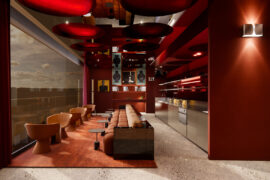Indesign Editor, Lorenzo Logi, discovers the value of ‘meaningful narratives’ in design culture, and why they are vital in communicating a regional design language, with Australian designer, Ross Didier.

January 13th, 2015
The stories born of the creative process are an invaluable marketing resource, but communicating them to the target audience is not always straightforward. Lorenzo Logi speaks with Ross Didier about his recently expanded ‘Fable’ collection to hear how the Australian designer has constructed a personal narrative around his work.
“I can’t help but start the product with a story, it’s just the way it happens with me”, says Didier. “If it doesn’t have a story I find it dull – the story gives it a reason to eventuate.”
As Didier highlights, stories give meaning to work and its finished product, elevating it beyond a simple collection of materials and techniques. This holds as much for a final owner as for a creator, and the encyclopaedic knowledge fevered collectors amass about the objects of their obsession is, to some extent, shared by any appreciator.
How then does a company communicate this story to a potential client? In the case of the ‘Fable’ collection, Didier has conceived of a set of whimsical images that capture his own sentiments about the work. “The intention was to personify [the products] – I’m really interested in trying to represent animism and create souls in products,” he explains.
“I really wanted to take it out of the real world, to that beautiful state of philosophy and beauty, and what I was thinking about at the time I came up with the concepts. The whole idea was to recall humble, simple designs, in the tradition of the children’s tale or storybooks. I wanted to present this range as if a craftsman had handcrafted it, but behind the craft these pieces are made by sophisticated machinery. It’s more difficult to make things look simple than vice versa”, he explains.
As rich and engaging as this approach is, however, Didier is aware of the need for the marketing strategy to remain accessible, and to rein in his artistic instinct lest it overshadow marketability. Thus as a counterbalance to the first round of images, Didier intends to photograph the products in a pure, minimal context (what he calls a ‘Japanese’ style) to allow his audience to imagine them in their own spaces.
Naturally the stories Didier steeps his work in – and the visual tools he uses to communicate them – are powerful defining features of his brand. In this regard Didier is conscious of not constraining himself; “I’d like to see Didier defined by the products that I’m creating – I don’t want to create a myth and the products to slip in to that. I want the products to tell the story – if a style emerges, then good.” So whilst each collection has a defined personality, these are distinct and reflect its individual evolution, rather than a repeated approach.
As a genuine representation of a designer’s inspiration and process, stories will also inevitably reflect their context and eventually nourish a design language of that context. For Didier, this is a very positive development – he states that “being able to define [that language] may be the key to Australia being successful in the global market; hopefully elements will emerge that are recognised as particularly Australian.”
This language is directly obvious in the presentation of Didier’s Terra Firma and Tiller collections, which having been strikingly photographed sitting in a baked, rural Australian context. “In Terra Firma and Tiller a lot of the form and inspiration was informed by hands and farm equipment, even the shapes, like timber shovel handles,” Didier explains.
Ultimately, for Didier the central purpose of the storytelling exercise is to reconnect with the true value of his work. “From a design point of view, the original idea is fascinating”, he says, “and in the commercial landscape you nearly have to add the trickery to make the products more sophisticated. But to pare it back is a challenge – it’s hard in the commercial world to portray and give emphasis to that simplicity and purity.”
Ross Didier
didier.com.au
INDESIGN is on instagram
Follow @indesignlive
A searchable and comprehensive guide for specifying leading products and their suppliers
Keep up to date with the latest and greatest from our industry BFF's!

CDK Stone’s Natasha Stengos takes us through its Alexandria Selection Centre, where stone choice becomes a sensory experience – from curated spaces, crafted details and a colour-organised selection floor.

For a closer look behind the creative process, watch this video interview with Sebastian Nash, where he explores the making of King Living’s textile range – from fibre choices to design intent.
Discarded books resurrected in a unique furniture range by Australian designer on the rise, Samantha Parsons
The internet never sleeps! Here's the stuff you might have missed

COX Architecture uses saturated colour and hotel-style amenity across the historic St Peters location, designed for Coronation Property.

Rising above the new Sydney Metro Gadigal Station on Pitt Street, Investa’s Parkline Place is redefining the office property aesthetic.